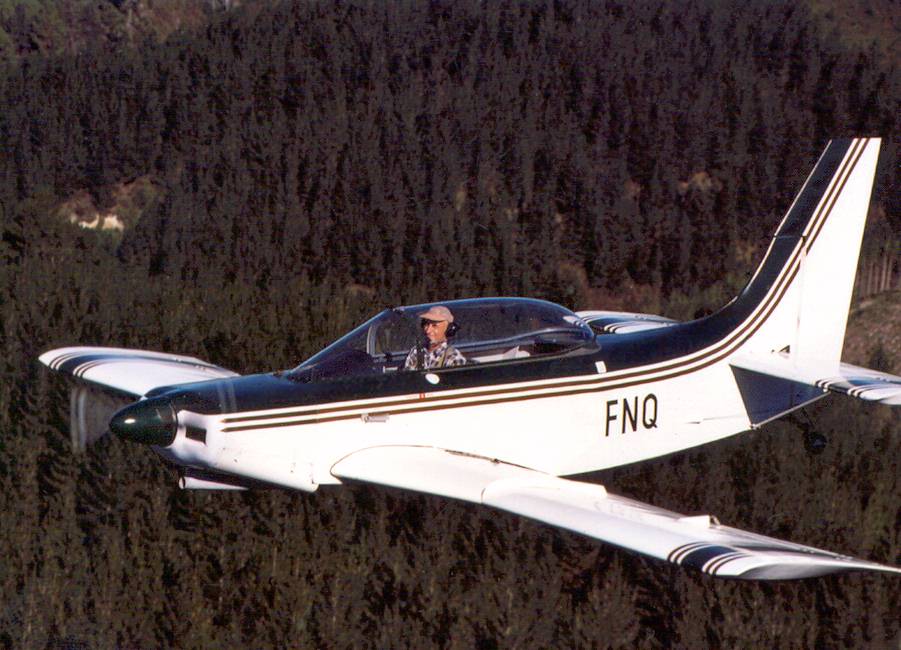| MJ-5 #71 | ZK-FNQ |
|
| Construction: 1977-1991 |
Moteur / Engine : Lycoming O-320 150 cv / hp - Voltige / Aerobatic | |
|
Fabrication en bois et toile, train rentrant et moteur 150 cv Lycoming O-320 (type MJ-5 G2) avec une hélice Sensenich 74x64 en métal. La vitesse de croisière est de 222 km/h à 65% de la puissance et la charge utile est 250 Kg. Vitesse de décrochage : 89-93 km/h selon la configuration. Il a été vendu à M. Philip H Meredith le 1er août 2007 qui en a fait une restauration complète jusqu'en 2009 et en a changé la décoration (photo ci-dessus).
Construction is wood and fabric covering. Powered by a 150hp Lycoming O-320 engine with a Sensenich 74x64 metal prop and a retractable gear (type MJ-5 G2), the cruise speed is 120 Kts @ 65% power and useful load is 550 lbs [250 Kg.] Article from New Zealand Aviation News (By Penny Belworthy): JUNE 2003, on a small airfield called Autun, near Lyon, Eastern France, the Jurca Air Force will be holding the thirteenth Jurca aircraft fly-in. This year the fly-in will be attended by Wyllie and Sue Evans from North Canterbury proud owner / builders of the Jurca Sirocco ZK-FNQ. From the design stable of Marcel Jurca the MJ-5 Sirocco is one of only two non warbird type aircraft in his portfolio. Jurca has been designing aircraft and war bird replicas since 1954. His first aircraft was the MJ-2 Tempete which is a low wing single seat aircraft of which over 100 have been built. After this he designed the MJ-5 Sirocco, a very sleek looking two seater with aerobatic capabilities. Named after the hot dry dusty South European wind that blows up from Africa in the spring time, the Sirocco is well at home in North Canterbury where the feisty 'Norwester' is the predominant spring wind The Jurca meeting was held in 1991 There was a low attendance of aircraft through bad weather but by 1992 the word had gone out and there were 15 Jurca designed aircraft in attendance. Sirocco profile: Because his aircraft have been so popular, in 1989 three Jurca plane lovers, Jean-Pierre Garibaldi, Maurice Genty and his son Jean-Louis Genty, decided to form the Jurca Air Force and have regular meetings. FNQ first flew back in July 1991 after 14 years in construction. The main structure is made out of spruce and the fuselage is covered with ply for strength. The wings have been made with the heavier spar to give the aerobatic option and have been covered with Ceconite fabric. Systems are simple with the mechanically operated flaps and the undercarriage is extended and retracted b means of a hand operated screw jack systern. One of the main reasons Wyllie was taken with this design was the spacious tandem cockpit with great all round visibility. It's real fighter style bubble canopy stuff. FNQ is powered with a 0-320 Lycoming engine which produces a cruise speed of around 120kts at 60% power. The design will accept engines ranging between 150 and 225hp. It uses 34 litres of avgas per hour and has an endurance of 3.5 hours. Fitted with an appropriate Sensenich fixed pitch propeller this gives a 1500 fpm rate of climb. Empty weight is listed a 1100lb (500kg) with a comfortable 600 lb payload. All Jurca aircraft are plans only construction. There are no kitsets. Consequently a basic skill level is required for wood and composite construction. There is no major metal component work save that in and around the firewall and landing gear mechanism. Construction time is variable. Some have been built in as little as 3500 hours but most are more leisurely projects and were begun when the access to all metal or composite kit aircraft was limited. There just wasn't the choice there is today. Wooden aircraft are undergoing a resurgence in the custom built world primarily among those who are looking for something that is a little different and has an established pedigree. There is something about wooden construction and the techniques required to create the aircraft. Wood is long lasting, has minimal fatigue problems and if kept dry will invariably outlast the builder. Coupled with modern adhesives and finishes looks the part alongside its metal and composite brethren. The MJ-5 is in good company with other plans built aircraft of the period, notably the F8L Falco and GP4. as the speed designs but it also shares a place with the host of Jodels, Corby Starlets which continue populate toNew Zealand skies The FNQ was sold to Philip H Meredith of Christchurch on August 1st, 2007. Since about that date the Sirocco has been undergoing a major refurbishment until 2009.
|
||
|
Situation :
|
Nouvelle Zélande, Christchurch | |
|
Liens / Links :
|
||






